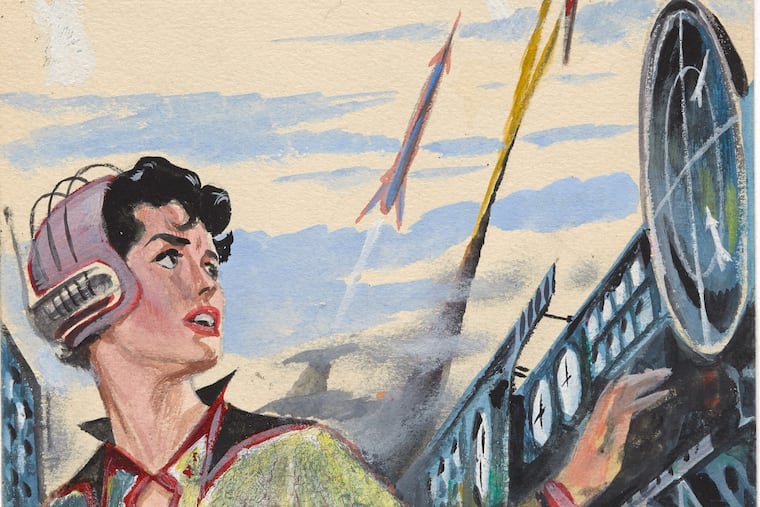This unsung genius of 20th century art has two Philly shows going on at the same time
Ed Emshwiller is a big-name attraction on Philadelphia's art gallery scene right now. Two more must-sees this month: the first in a series of guest-curated shows at Moore and a big craft-art exhibit in Frankford that is worth the effort of booking a visit.

Ed Emshwiller, who died in 1990 at age 65, was one of those multimedia artists who tried so many different things that his name got a little lost in late 20th-century art history. Now, thanks to exhibitions running concurrently at the Lightbox Film Center and the University of the Arts, Emshwiller’s groundbreaking work is getting the recognition it deserves.
“Dream Dance: The Art of Ed Emshwiller” brings together Emshwiller’s films — being screened at Lightbox — and his videos, sketches, paintings, illustrations, and ephemera, on exhibit at UArts’ Rosenwald-Wolf Gallery.
» READ MORE: Lightbox Film Center to move to Broad Street
Emshwiller wasn’t a dabbler; he was an accomplished polymath. Between 1951 and 1964 (and occasionally after that), the Michigan-born artist created hundreds of book-cover paintings and page illustrations for science-fiction paperbacks and magazines. He earned five Hugo Awards in sci-fi publishing.
In the late 1950s, Emshwiller also began making expressionistic abstract paintings and recording his progress in short, stop-motion films. A Ford Foundation grant in 1964 paved the way for filmmaking that was more experimental. By the 1970s he was also creating multimedia performance pieces and working as a cinematographer on documentaries.
In 1987, while serving as dean at the California Institute of the Arts’ film school, he created the pioneering electronic video opera, Hunger, in partnership with composer Morton Subotnick.
At the Rosenwald-Wolf Gallery, the brilliance of Emshwiller’s mind is clear from his earliest works, including a complex ink-on-paper drawing he made at age 14, signed “Eddie Emshwiller ’39.” There’s a masterful self-portrait from 1942, a few years later.
After serving in World War II, Emshwiller studied art at the University of Michigan, the Ecole des Beaux Arts in Paris, and the Art Students League of New York. By 1947, he was drawing and painting grotesque figures in bizarre scenes that seem to have been influenced by Salvador Dali’s surrealist paintings, Francisco Goya’s gruesome The Disasters of War, and comic strips of the day.
» WATCH: This clip from the Lightbox website will give you a sense of Emshwiller’s groundbreaking video art
From there, Emshwiller’s cover art for sci-fi publications seems like a natural development. The UArts exhibition includes an enormous display of sci-fi paperbacks with Emshwiller’s covers. His vivid paintings were so compelling that publishers would occasionally buy them first and then assign an author to write a story based on them.
Abstract painting was not Emshwiller’s strong suit, judging from the few offerings here. Representational painting seems to have stymied him, too, as in a moody portrait of his wife, Carol.
The videos in the Rosenwald-Wolf exhibition are much better, including his iconic computer-generated, 3D Sunstone (1978) and Skin Matrix (1984). In these, as with his book work, he seems driven to express his out-there ideas to the fullest degree possible, but in a way that might resonate with anyone, not just those well versed in contemporary art.
Through Dec. 7 at Rosenwald-Wolf Gallery, University of the Arts, 333 S. Broad St., 10 a.m.-5 p.m. Mon.-Fri., noon-5 p.m. Sat. 215-717-6480 or www.uarts.edu/about/rosenwald-wolf-gallery.Lightbox Film Center, 3701 Chestnut St., 215-895-6590 or lightboxfilmcenter.org.
Mia Locks curates at Moore
The new exhibition “Or Both,” organized by Mia Locks from the Museum of Contemporary Art Los Angeles, is the first of three shows being put together by visiting curators for a new series at Moore College of Art & Design — and it augurs great things for the series’ future.
Locks’ show highlights enamel paintings by Austrian-born artist Ulrike Müller, which appear alongside works by others, including Martin Beck, Barbara Chase-Riboud, Jennie C. Jones, Eric N. Mack, Medrie MacPhee, Dona Nelson, and Deborah Remington.
» READ MORE: Moore brings in three high-powered curators to create edgy exhibitions at the art school
It’s a quirky, sophisticated show, and a good start. (And if the curator’s name rings a bell, it could be because she’s the daughter of Sueyun Locks, director of Philadelphia’s Locks Gallery.)
The next visiting curator in the Moore series will be Kalia Brooks Nelson, who teaches at NYU’s Tisch School of the Arts, followed by Charlotta Kotik, former head of the Brooklyn Museum’s modern and contemporary art department.
Through Dec. 7 at the Galleries at Moore, Moore College of Art & Design, 1916 Race St., 11 a.m.-5 p.m. Mon.-Sat. 215-965-4027 or moore.edu/the-galleries-at-moore.
‘Then and Now’: Catch it soon
"Philadelphia Then and Now: 1950-2019” is a terrific show of craft-oriented works that’s open only by appointment and closes a week from now. It’s worth your trouble to fit it in.
The exhibition, at the Globe Dye Works building in Frankford, offers a selection of recent craft-oriented works curated by Bertrand Productions, plus earlier works selected by Philadelphia craft-art doyenne, Helen W. Drutt English.
It’s a who’s who of Philadelphia-based artists, including Harry Anderson, Jill Bonovitz, Lewis Knauss, Robert Lugo, Sharyn O’Mara, Judith Schaecter, Ken Vavrek, and more.
Through Nov. 10 at Globe Dye Works, 4500 Worth St., by appointment only. 317-604-7162 or bertrandproductions.com.